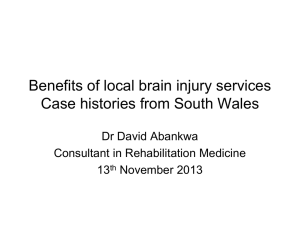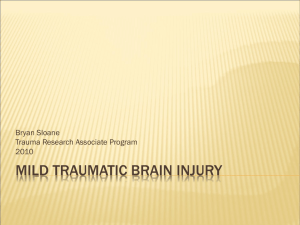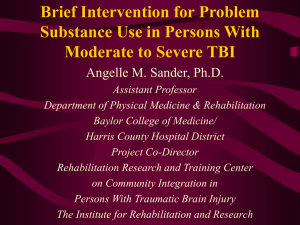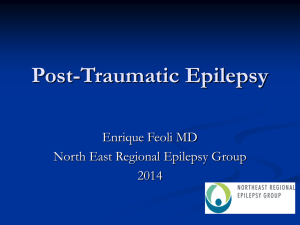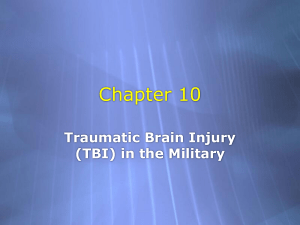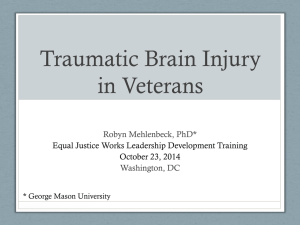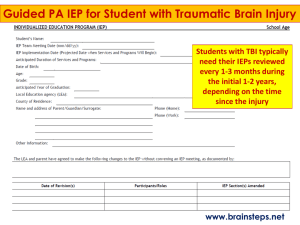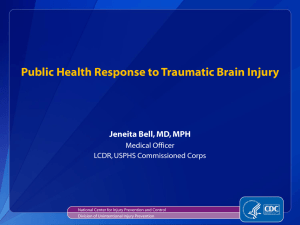TBI Secondary to Distal Ballistic Injury
advertisement
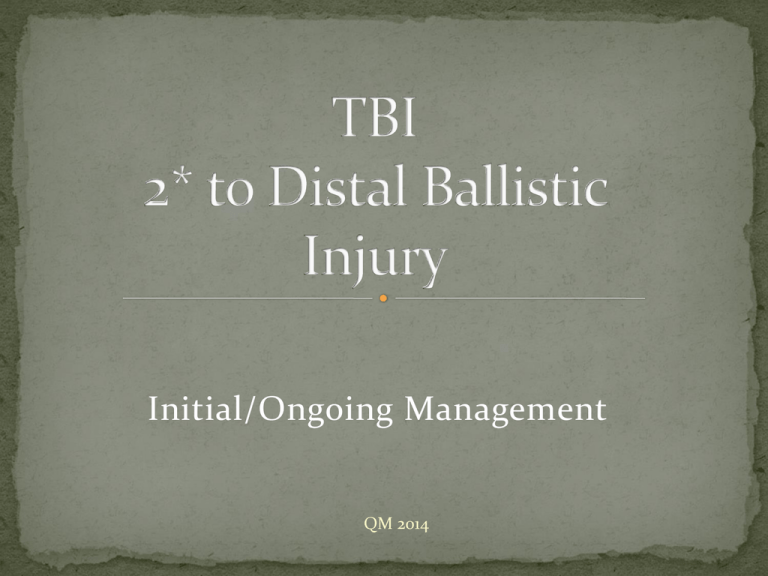
Initial/Ongoing Management QM 2014 Before we begin; EBR on TBI secondary to ballistic wounds appear contradictory Following is based on 1. US, UK, ADF conflict stats 2. Civilian critique of research methods by Smith et al. 3. Hellenic Military Academy – ‘unique’ U.S. Civilian Forensic Experts, Texas, USA QM 2014 Basic background to Ballistics Hi/Low Velocity Rounds Basic Wound Types Upon Presentation (What to look for) Secondary complications/ ‘Sequelae’ Initial /Ongoing Management QM 2014 KISS No two situations are the same. However, if the victim is able to give: 1. Distance – approximate (from assailant) 2. Round Type – Pistol or longarm (rifle) Management approach can be pre-empted But first the basic differences in weapon types … QM 2014 Muzzle velocity is the initial speed of the round as it exits the barrel – particular relevance to close proximity pistol round wounds Pistol rounds (9mm) have relatively high muzzle velocity, 300 – 350m/s, with exceptional penetrating power at short distances for both soft and hard nose rounds (round = bullet) Rapid decrease in velocity over short distance (20 - 60 metres) QM 2014 picsbox.biz/key/9mm bullet drop chart globalsecurity/.org Any form of deflection, obstacle has significant effect on penetrating power eg. thin, outer panel of car door (mushrooming, tumbling). Centrefire longarms have higher muzzle velocity, 900 – 950 m/s and higher speeds over longer distances – due to design, rifling – as opposed to pistol rounds. QM 2014 guns.com High Velocity Rounds Bone - Shattering - Non-Reparable - Complex, distal effects High Velocity Rounds Flesh – Depends on round type - Tumbling - Penetrating Tumbling – Extensive, complex Penetrating – Possibility of very little damage as opposed to low velocity rounds QM 2014 Low Velocity Rounds Bone - Lower possibility of shattering - Significantly reduced possibility of distal effects, TBI Flesh - Depends on round type (hollow point) - Likelihood of extensive damage, used deliberately in CQB, by SF/SO QM 2014 Not all research papers recognise the significant difference in round velocity to distance in handgun bullet wounds ‘(In ballistic wounds) the essential condition is the distance to target’ - Alexandropoulou & Panagiotopoulos, 2012 QM 2014 In summary, large calibre longarms and most pistols (9mm +) at close range significantly increase likelihood of TBI from pressure waves Pistols at ‘most’ distances cause significant damage to flesh Victim may be ‘lucky’ with high velocity flesh wound from a longarm* QM 2014 In addition to the penetration medium (bone, flesh or combination) three other factors affect wound type Permanent cavity destroyed upon entry – missile morphology and velocity Fragmentation – missile or bone – not all wounds AND …. QM 2014 Temporary cavity (5 – 12cm radius) – extension of permanent cavity by kinetic energy transported in tissues by missile – Serious implications for surgery within the first 3 hour window in assessing tissue to be excised. Vasospasm – approx. 3 hrs. from hi-vel. wound – colour, bleeding, contractility and consistency parameters for surgery assessment. 3 hrs. vasospasm/constriction followed by hyperaemia* QM 2014 TBI from a distal injury not to be confused with injuries from the temporary cavity. ‘Injuries from the temporary cavity are more common in closer proximity to less elastic (brain, liver spleen), fluid filled and dense tissue. Elastic tissue (skeletal muscle) and lower density (lung) are less affected.’ Snow and Bozeman, 2010 QM 2014 Pressure Wave induced TBI ‘ … instantaneous perturbation of dentate interneuronal networks by a transient pressure wavedelivered to the neocortex (2)’ Results from combined human (DVBIC) USA), animal and simulated compound research Neuron loss in the hippocampus – Hilus of the dentate gyrus due to pressure wave Cells are large and not tightly packed QM 2014 Wikipedia Commons Wikipedia Commons TBI - Damage to the hippocampus, then damage to the hypothalamus if pressure wave strong enough BBB - appears to open periodically within first 24 hours of TBI – allowing passage of proteins and substances otherwise excluded from the brain . Alterations to brain osmolarity and oedema formation QM 2014 Over expression of Aquaporin channels – permit movement of water into lateral ventricles > exacerbate cerebral oedema Glutamate (excitatory neurotransmitter) causes influx of Sodium and calcium > hi intra cellular concentrations after TBI. QM 2014 Excess Calcium initially buffered by sarcoplasmic reticulum, eventually saturated, excess taken up by mitochondria acting as ‘calcium sink’ under stress situations With other stimuli, mitochondrial permeability transition pore forms > depolarization, swell with calcium intake, leak due to intra-organelle oedema and ATP production becomes deficient. In a highly metabolically active cell > energy failure. Cytochrome C is also released which promotes apoptosis. High IC Ca+ attacks cytoskeleton, cytosolic proteins and DNA structures QM 2014 And; Head impact after insult – compounding factor QM 2014 A – Airway – C Spine protection/Haemorrhage control B – Breathing C – Circulation/Compressions D – Defib./Disability Observe for: Ecchymosis (do not confuse w/bruising) Paralysis of face muscles Declination of eyes to one side CSF liquid from ear, nose or wound One short, lucid interval followed by reduced LOC, headache, nausea and vomiting QM 2014 • Fluids • Oxygen • BGLs - Insulin QM 2014 Ideal state – Eu to moderate hypervolaemia Isotonic and hypertonic fluids – essential early intervention to maintain cerebral perfusion. To be managed with delayed hyperaemia that can lead to cerebral oedema and inc. ICP NS not Lactated Ringers/Hartmann's QM 2014 Fluids do not replace O2 carrying capacity. At some point blood will have to be given in severe cases. ICP to be maintained at < 20mmHg and CPP at >60mmHg (hospital based monitoring) QM 2014 O2 – caution excess Up to 50% pre-hospital admissions, inadvertent hyperventilation leads to pCO2 < 33mmHg > incr. mortality in patients with TBI. Hypocapnea - Implications for vasoconstriction , reduced cerebral blood flow and regional ischemia. QM 2014 O2 – Caution excess/under use Insufficient O2 - Common problems associated with TBI are changing LOCs and transient periods of hypoxia. Hypoxic periods > bradycardia in TBI patients and exacerbate secondary brain injury QM 2014 IIT background Lantus/Levemir, medium short acting if time, circumstances permit Glucose Constant BGL monitoring Conservative control, both hyper and hypoglycaemia can aggravate primary brain injury Insulin – assess short, medium, long acting Serious implications for brain energy ‘Meta-analysis’ – does not support IIT QM 2014 Hypothermia Randomized trials at 37 & 30 Degrees Celsius Reduce glutamate release and free radical production after TBI. Essential to maintain therapeutic levels for CNS signalling. Excess glutamate responsible for neurological dysfunction associated with TBI. Glutamate levels increase by over 250% in the dentate gyrus alone in mild brain injury QM 2014 Magnesium Salts – with mannitol to improve brain bio-availability - Mg down regulates aquaporin 4 reducing cellular oedema* MgSO4 induces smooth muscle relaxation, principally in the airway Clinical trials stating that Mg was of no benefit – pts required intracranial brain surgery within 8 hrs or had the GCS of a rocking chair Cyclosporine A – inhibit opening of the mitochondrial permeability transition pore. QM 2014 DVT/PE Prophylaxis Compression stockings Hold LMW heparin/low dose unfractionated heparin until 48 – 72 hours after admission – possible risk for expansion of intracranial haemorrhage Stress Ulcer Prophylaxis (Severe TBI) PPI infusion – most effective (Pantoprazole) H2 blockers – block histamine, reduce enteric acid (location) Sucralfate – duodenal ulcers – specific to stress ulcer proph. Early enteral feeding QM 2014 Avoid: Calcium channel blockers Reduce systemic blood pressure and CPP Corticosteroids Bleeding, hyperglycaemia, increase in cerebral metabolic rate and fluid retention QM 2014 Principally hospital based Prevent sequelae – ischemia, haematoma, vasospasm Pulse Oximetry Intraparenchymal Brain Catheters increasing in use due to ease, versatility and ‘short learning curve’ (ICU) ICP and PtiO2/PbrO2/PBTO2 determine treatment QM 2014 To determine benefits of MgCl2 over MgSO4 – possibility of reduced toxicity with MgCl2 Possible benefits of Substance P inhibitors in TBI patients Oestrogen and Progesterone in TBI management Mg in combination with Tirilazad – nonglucocorticoid neuroprotectant to reduce vasospasm B2 – Antioxidant, NS function Dexanabinol – anticonvulsant, neuroprotectant QM 2014 Tape paper bags to the hands of GSW victims until police swabs completed Place any cut/discarded clothing in paper, not plastic bags due to condensation and damage to potential evidence. QM 2014 Alexandropoulou, C., & Panagiotopoulos, E. (2010). Wound Ballistics: Analysis of Blunt and Penetrating Trauma Mechanisms. Health Science Journal, 4(4), 225-236. Courtney, A., & Courtney, M. (2007). Links between traumatic brain injury and ballistic pressure waves originating in the thoracic cavity and extremities. Brain Injury, 21(7), 657662 Davis, D., Fakhry, S., Wang, H., Bulger, E., Domeier, R., Trask, A., & ... Robinson, L. (2007). Paramedic rapid sequence intubation for severe traumatic brain injury: perspectives from an expert panel. Prehospital Emergency Care, 11(1), 1-8. Dr. Vincent J. M. Di Maio, Chief Medical Examiner and Director of the Regional Crime Laboratory, County of Bexar, San Antonio, Texas (from his Gunshot Wounds, CRC Press, Boca Raton, FL, 1985). Sen, A, & Gulati, P. (2010). Use of Magnesium in Traumatic Brain Injury. Neurotherapeutics: The Journal of the American Society for Experimental NeuroTherapeutics. Snow, A., & Bozeman, J. (2010). Role implications for nurses caring for gunshot wound victims. Critical Care Nursing Quarterly, 33(3), 259-264 Wallace, D. (2009). Improvised explosive devices and traumatic brain injury: the military experience in Iraq and Afghanistan. Australasian Psychiatry, 17(3), 218-224. QM 2014 DVT Prophylaxis http://www.sjtrem.com/content/20/1/12 IPBC; http://www.slideshare.net/pgpapanikolaou/083009pa panikolaoupanagiotis439744 The Dentate Gyrus; http://www.jle.com/en/revues/bio_rech/mrh/edocs/00/04/11/9B/article.phtml QM 2014


